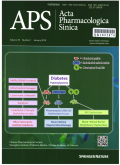- 钛学术文献服务平台 \
- 学术期刊 \
- 医药卫生期刊 \
- 药学期刊 \
- 中国药理学报(英文版)期刊 \
依他尼酸抑制胰腺外分泌
依他尼酸抑制胰腺外分泌
基本信息来源于合作网站,原文需代理用户跳转至来源网站获取
摘要:
AIM: The effect of ethacrynic acid on pancreatic exocrine secretion function and potential mechanisms of interference with the secretory process in pancreatic acinar cells were investigated. METHODS: After incubation with ethacrynic acid for 30 min, caerulein-stimulated amylase release and cholecystokinin (CCK) receptor binding characteristics were assessed in isolated rat pancreatic acini. The level of thiol groups (glutathione and protein thiols ) and cytosolic free calcium were measured in pancreatic acinar cells. RESULTS:Ethacrynic acid decreased caerulein (0. 1 nmol/L )-stimulated amylase release and the level of pancreatic acinar glutathione in a concentration-dependent fashion without a marked increase in cell damage. Ethacrynic acid also inhibited the caerulein (1 nmol/L)-induced Ca2+ mobilization in pancreatic acinar cells. But neither protein thiol nor CCK-receptor binding characteristics was altered by ethacrynic acid. CONCLUSION: Ethacrynic acid inhibit pancreatic exocrine secretion by depletion of glutathione and down-regulation of caerulein-induced Ca2+ mobilization. Glutathione might play a potential role in the secretory process in pancreatic acinar cells and in the secretory blockade observed in acute pancreatitis.

推荐文章
胰腺外分泌功能的MRI研究进展
胰腺外分泌功能
磁共振胆胰管成像
扩散加权成像
磁共振成像
妊娠期胰腺外分泌功能测定及其临床意义
妊娠
胰腺外分泌功能
粪胰腺弹力蛋白酶-1
食欲不振
姜黄素对辐射诱导的胰腺外分泌细胞损伤的保护作用
姜黄素
辐射防护
HIF-1α
能量代谢
线粒体
游离脂肪酸对大鼠胰岛细胞体外分泌功能的影响
游离脂肪酸
软脂酸
油酸
胰岛细胞
葡萄糖刺激的胰岛素分泌
内容分析
关键词云
关键词热度
相关文献总数
(/次)
(/年)
文献信息
| 篇名 | 依他尼酸抑制胰腺外分泌 | ||
| 来源期刊 | 中国药理学报(英文版) | 学科 | 医学 |
| 关键词 | 依他尼酸 胰腺 外分泌腺 谷胱甘肽 | ||
| 年,卷(期) | 2001,(11) | 所属期刊栏目 | |
| 研究方向 | 页码范围 | 961-965 | |
| 页数 | 5页 | 分类号 | R96 |
| 字数 | 语种 | 英文 | |
| DOI | |||
五维指标
引文网络
引文网络
二级参考文献 (0)
共引文献 (0)
参考文献 (23)
节点文献
引证文献 (0)
同被引文献 (0)
二级引证文献 (0)
1969(1)
- 参考文献(1)
- 二级参考文献(0)
1984(1)
- 参考文献(1)
- 二级参考文献(0)
1985(1)
- 参考文献(1)
- 二级参考文献(0)
1986(1)
- 参考文献(1)
- 二级参考文献(0)
1987(1)
- 参考文献(1)
- 二级参考文献(0)
1988(1)
- 参考文献(1)
- 二级参考文献(0)
1990(2)
- 参考文献(2)
- 二级参考文献(0)
1994(1)
- 参考文献(1)
- 二级参考文献(0)
1996(1)
- 参考文献(1)
- 二级参考文献(0)
1997(4)
- 参考文献(4)
- 二级参考文献(0)
1998(1)
- 参考文献(1)
- 二级参考文献(0)
1999(2)
- 参考文献(2)
- 二级参考文献(0)
2000(5)
- 参考文献(5)
- 二级参考文献(0)
2001(1)
- 参考文献(1)
- 二级参考文献(0)
2001(1)
- 参考文献(1)
- 二级参考文献(0)
- 引证文献(0)
- 二级引证文献(0)
研究主题发展历程
节点文献
依他尼酸
胰腺
外分泌腺
谷胱甘肽
研究起点
研究来源
研究分支
研究去脉
引文网络交叉学科
相关学者/机构
期刊影响力
中国药理学报(英文版)
主办单位:
中国药理学会和中科院上海药物研究所
出版周期:
月刊
ISSN:
1671-4083
CN:
31-1347/R
开本:
大16开
出版地:
上海市太原路294号
邮发代号:
4-295
创刊时间:
1980
语种:
eng
出版文献量(篇)
4416
总下载数(次)
2
总被引数(次)
42236
期刊文献
相关文献
推荐文献
- 期刊分类
- 期刊(年)
- 期刊(期)
- 期刊推荐
中国药理学报(英文版)2022
中国药理学报(英文版)2021
中国药理学报(英文版)2020
中国药理学报(英文版)2019
中国药理学报(英文版)2018
中国药理学报(英文版)2017
中国药理学报(英文版)2016
中国药理学报(英文版)2015
中国药理学报(英文版)2014
中国药理学报(英文版)2013
中国药理学报(英文版)2012
中国药理学报(英文版)2011
中国药理学报(英文版)2010
中国药理学报(英文版)2009
中国药理学报(英文版)2008
中国药理学报(英文版)2007
中国药理学报(英文版)2006
中国药理学报(英文版)2005
中国药理学报(英文版)2004
中国药理学报(英文版)2003
中国药理学报(英文版)2002
中国药理学报(英文版)2001
中国药理学报(英文版)2000
中国药理学报(英文版)1999
中国药理学报(英文版)1998
中国药理学报(英文版)2001年第9期
中国药理学报(英文版)2001年第8期
中国药理学报(英文版)2001年第7期
中国药理学报(英文版)2001年第6期
中国药理学报(英文版)2001年第5期
中国药理学报(英文版)2001年第4期
中国药理学报(英文版)2001年第3期
中国药理学报(英文版)2001年第2期
中国药理学报(英文版)2001年第12期
中国药理学报(英文版)2001年第11期
中国药理学报(英文版)2001年第10期
中国药理学报(英文版)2001年第1期

 免费查重
免费查重










